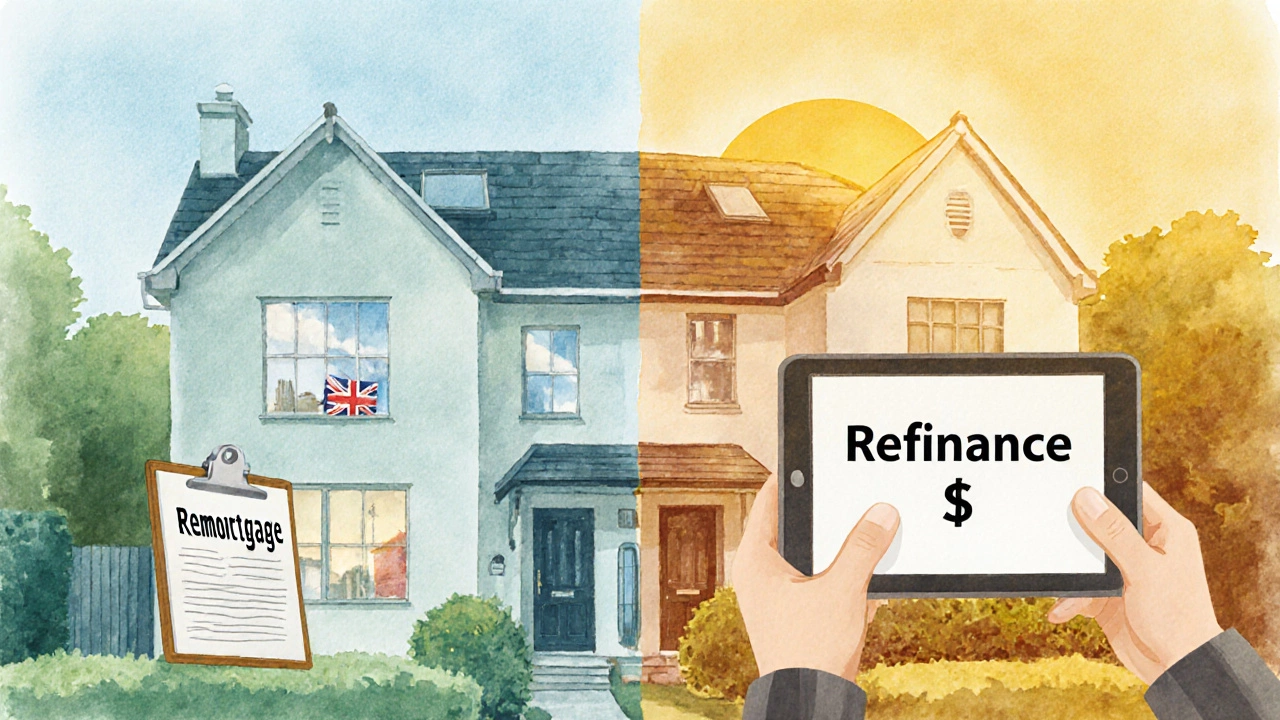Remortgage vs Refinance Cost Calculator
Calculate your results by entering details above
Results will appear here after calculation
Key Insight
Your break-even period determines if switching makes sense. If you plan to stay longer than this period, you'll save money.
When you hear people talk about remortgage is a process where you replace your existing mortgage with a new one, usually to get a better rate or change the loan terms, it can feel like finance‑speak you don’t need. Across the pond, the same idea is called refinance and is described as taking out a fresh loan to pay off the current mortgage, often to lower monthly payments or tap equity. If you’re wondering whether they’re the same thing, you’re in the right place. Below we’ll break down the two, compare the costs, and help you decide which path matches your goals.
How a Remortgage Works in the UK
A remortgage typically involves three steps: (1) finding a lender who offers a better deal, (2) applying for a new loan that will cover your existing mortgage balance, and (3) completing the legal paperwork to transfer the loan. Most homeowners do it when their fixed‑rate period ends, but you can also remortgage mid‑term if rates drop dramatically.
- Check your current loan‑to‑value (LTV): The lower your LTV, the more options you’ll have. LTV is the loan amount divided by the property’s market value.
- Shop around: Use comparison sites or talk to a mortgage broker who can match you with lenders that suit your credit profile.
- Consider fees: Arrangement fees, valuation costs, and possibly an early repayment charge if you’re still in a fixed‑rate agreement.
When the paperwork is done, the new lender pays off the old mortgage and you start making payments on the fresh deal.
What Refinance Means in the US (and How It Maps to the UK)
In the United States, refinance follows a similar three‑step flow: find a lower‑rate loan, apply, and close. The key difference is the terminology and a few regulatory nuances.
- U.S. borrowers often use refinance to cash out equity - pulling out a lump sum for home improvements, debt consolidation, or other big expenses.
- American lenders may offer a wider range of products like adjustable‑rate mortgages (ARM) or interest‑only loans.
- Closing costs can be higher, sometimes 2‑5% of the loan amount, but they’re often rolled into the new loan.
Even though the word changes, the core idea-replacing an old loan with a new one-is identical.
Side‑by‑Side Comparison
| Aspect | Remortgage (UK) | Refinance (US) |
|---|---|---|
| Primary Goal | Secure a lower rate or change loan terms | Lower rate, cash‑out equity, or different product |
| Typical Fees | Arrangement fee, valuation, possible early repayment charge | Closing costs, appraisal fee, sometimes points |
| Credit Check Impact | Hard pull; may affect score briefly | Hard pull; similar impact |
| LTV Limits | Usually up to 95% for first homes, lower for buy‑to‑let | Often up to 80% for cash‑out, higher for rate‑and‑term |
| Regulatory Body | Financial Conduct Authority (FCA) | Consumer Financial Protection Bureau (CFPB) |
| Common Products | Fixed‑rate, variable‑rate, tracker mortgages | Fixed‑rate, adjustable‑rate, interest‑only, FHA/VA loans |
When a Remortgage Makes Sense
Consider a remortgage if any of these apply:
- Your fixed‑rate period has ended and current rates are lower.
- You’ve built up equity and want to lock in a better LTV, which could slash your monthly payment.
- You need to switch from a variable rate to a fixed rate for stability.
- You’re planning to consolidate high‑interest personal loans into your mortgage.
Just remember to crunch the numbers. A lower rate looks great, but if the arrangement fee is £1,000 and you’ll only stay in the house for another two years, the savings might not cover the cost.

When Refinance Is the Better Option
Refinance shines in these scenarios:
- You want to pull out cash for a kitchen remodel or to pay down credit‑card debt.
- Your credit score has improved dramatically since you first took out the loan, qualifying you for a significantly better rate.
- You’re interested in an ARM that could lower payments in the first few years.
- You’re moving from an FHA loan to a conventional loan to eliminate mortgage insurance premiums.
Again, calculate the total cost. Adding a lump sum to the loan extends the repayment term, which can increase the total interest paid over the life of the loan.
How to Compare Costs Accurately
Use this quick checklist before you sign anything:
- Interest rate - note the APR, not just the headline rate.
- Fees - arrangement, valuation, appraisal, and any closing costs.
- Early repayment charge - especially relevant for fixed‑rate UK deals.
- Monthly payment change - run the numbers for both scenarios.
- Total interest over the remaining term - the long‑run view matters.
If the numbers line up, you’ve got a solid case for either a remortgage or a refinance.
Common Pitfalls and How to Avoid Them
Even seasoned homeowners slip up. Here are the most frequent mistakes and the fix for each:
- Ignoring the break‑even point: Calculate how many months you need to stay in the property before the savings outweigh the fees.
- Skipping the credit check: A dip in your credit score can raise your rate, wiping out any potential benefit.
- Forgetting about valuation risk: Lenders may lower the offered amount if the property value falls, pushing your LTV higher.
- Choosing the wrong product: Fixed‑rate gives certainty, but variable can be cheaper if rates keep falling. Match the product to your risk tolerance.

Step‑by‑Step Guide to a Successful Remortgage
- Gather your current mortgage statement, recent payslips, and a proof of identity.
- Check your equity - the difference between market value and loan balance.
- Use a comparison website or speak to a broker to shortlist three lenders.
- Request a full quote, including all fees and the APR.
- Apply to your chosen lender - they’ll run a credit check and an affordability assessment.
- Schedule a property valuation; the lender will arrange it.
- Review the offer, sign the contract, and let the new lender settle with your existing mortgage holder.
- Set up your new payment method and confirm the first payment date.
Within 4‑6 weeks you should be on the new deal.
Step‑by‑Step Guide to a US Refinance
- Collect recent tax returns, W‑2s, and current mortgage statements.
- Run a quick credit score check (many banks offer free checks).
- Decide if you want a cash‑out refinance and how much you need.
- Shop for lenders - consider banks, credit unions, and online lenders.
- Obtain rate quotes and compare closing costs.
- Submit a formal application; the lender will order an appraisal.
- Review the loan estimate, negotiate any fees if possible.
- Close the loan - sign paperwork and pay closing costs (or roll them in).
Typically the process takes 30‑45 days.
Bottom Line: Are They the Same?
Short answer: yes, the mechanics are identical - you replace an existing mortgage with a new one. The difference lies in regional terminology, typical fee structures, and the extra cash‑out option common in the US. Whether you call it a remortgage or a refinance, the real work is checking rates, crunching numbers, and making sure the new deal actually saves you money.
Can I remortgage if I have an ARM?
Yes. An adjustable‑rate mortgage (ARM) can be switched to a fixed‑rate deal or a new ARM with better terms, provided the lender approves your credit and LTV.
Do I need a valuation for a cash‑out refinance?
A lender will always order an appraisal to confirm the property’s current market value before approving a cash‑out amount.
Will a remortgage affect my credit score?
A hard credit inquiry is recorded, which may dip your score by a few points, but the impact is usually short‑lived.
Is it cheaper to refinance with a bank or an online lender?
Cost varies. Online lenders often have lower overhead and can offer better rates, but banks may provide fee waivers for existing customers. Compare APR, fees, and services.
What’s the typical break‑even period for a remortgage?
Usually 12‑24 months, depending on arrangement fees and how much your rate drops. Run the numbers to be sure.
